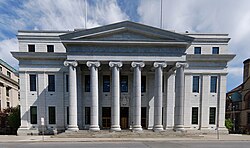New York Court of Appeals Building
|
New York State Court of Appeals Building
|
|

West (front) elevation, 2009
|
|
|
Location within New York
|
|
| Location | Albany, NY |
|---|---|
| Coordinates | 42°39′8″N 73°45′13″W / 42.65222°N 73.75361°WCoordinates: 42°39′8″N 73°45′13″W / 42.65222°N 73.75361°W |
| Built | 1842 |
| Architect | Henry Rector |
| Architectural style | Greek Revival |
| Part of | Lafayette Park Historic District (#78001837) |
| NRHP Reference # | 71000520 |
| Added to NRHP | February 18, 1971 |
The New York Court of Appeals Building, officially referred to as Court of Appeals Hall, is located at the corner of Eagle and Pine streets in central Albany, New York, United States. It is a stone Greek Revival building designed in the mid-19th century by Henry Rector. In 1971 it was listed on the National Register of Historic Places, one of six buildings housing a state's highest court currently so recognized. Seven years later it was included as a contributing property when the Lafayette Park Historic District was listed on the Register.
At the time it was built it was known simply as the State Hall, housing not the court (which sat in the state capitol) but its clerks. In addition to them, it was the offices of several other officials of the state's executive branch. Four years after its completion, a new state constitution was adopted, uniting two separate court hierarchies into one with the Court of Appeals as the highest court in the state. Rector's design incorporates all three classical orders in the building's rotunda, and uses stone arches to support the ceilings in an early attempt at fireproofing. It is one of only two extant buildings known to have been designed by him. Other architects were involved in later work on the building. Henry Hobson Richardson designed the courtroom, originally located in the nearby state capitol in the 1880s and described by a visiting Lord Coleridge as "the finest ... in the world". Lewis Pilcher oversaw a rear addition in the early 20th century when the courtroom was moved.
...
Wikipedia

